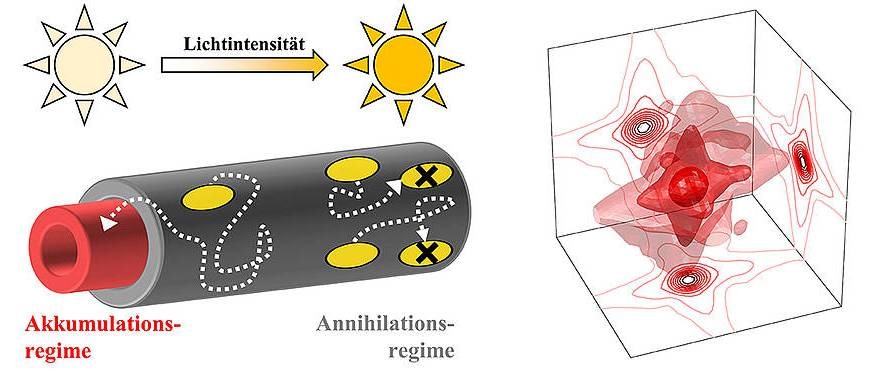Oct 22 2019
For photovoltaics and other technical applications, it is important that energy is efficiently distributed within a small volume. At present, new methods have enabled the path of energy in the range of nanometers to be traced accurately.
 Energy transport in biomimetic nanotubes (left) and a three-dimensional spectrum (right). (Image credit: Björn Kriete (left)/Stefan Mueller (right))
Energy transport in biomimetic nanotubes (left) and a three-dimensional spectrum (right). (Image credit: Björn Kriete (left)/Stefan Mueller (right))
The path is shown by plants and bacteria. They are capable of capturing solar energy using light-harvesting antennas and transporting it to a reaction center. Efficient and target energy transport in a reduced space has gained considerable attention. Mastering it perfectly would enable researchers to considerably optimize photovoltaics and optoelectronics.
Two New Spectroscopic Methods
But how can the energy flow be monitored? Currently, Tobias Brixner’s team at the Institute of Physical and Theoretical Chemistry at Julius-Maximilians-Universität (JMU) Würzburg, Bavaria, Germany, is investigating on this.
The team has currently reported the observation of two new spectroscopic techniques that can transport energy on the nanoscale in Nature Communications. As stated by the JMU professor, the outcomes of the new study offer useful data for designing artificial light-harvesting antennas.
The study was performed successfully together with the working groups of Christoph Lambert and Todd Marder from JMU Würzburg, Uwe Bunz, and Andreas Dreuw from the University of Heidelberg, and Jasper Knoester and Maxim Pshenichnikov from the University of Groningen, the Netherlands.
Nanotubes Mimic Nature
With the help of new methods, researchers were able to fully understand the transport of energy in double-walled nanotubes made up of thousands of dye molecules. Such small tubes can act as models for the light-harvesting antennas of photosynthetically active bacteria.
At low intensities of light, the energetic excitations are carried from the outer wall to the inner wall of the tubes. By contrast, at high intensities of light, the excitations can only travel along the outer wall—when two excitations come into contact with one another at this point, one of them vanishes.
This effect, which has been known for some time, can be made directly visible with our method for the first time.
Tobias Brixner, Institute of Physical and Theoretical Chemistry, Julius-Maximilians-Universität Würzburg
To perform the measurements, the researchers integrated the exciton-exciton-interaction-two-dimensional spectroscopy (EEI2D spectroscopy) method developed by the Brixner group with a microfluidic arrangement of the Groningen group.
Data Acquisition is Much Faster
In their second study, the researchers have also shown a new method to determine energy flows. The best part of this method was that the data recording speed could be considerably increased than with modern methods. The data of 15 different 3D spectra could be obtained in eight minutes simultaneously in a single experiment. However, conventional methods, in general, require several hours to obtain just a single spectrum.
As a standard for recording coherent spectra over three frequency dimensions, the scientists used a quick method of changing the temporal sequence of ultrashort laser pulses.
The expansion from 2D to 3D frequency analysis and the increase in the number of light-matter interactions from the four usual in the literature to six now provides detailed insights into the dynamics of highly excited states.
Tobias Brixner, Institute of Physical and Theoretical Chemistry, Julius-Maximilians-Universität Würzburg
Funding
This study was financially supported by the Solar Technologies Go Hybrid research network of the Free State of Bavaria, the German Research Foundation (DFG), and the European Research Council (ERC) as part of the ERC consolidator grant “MULTISCOPE.”